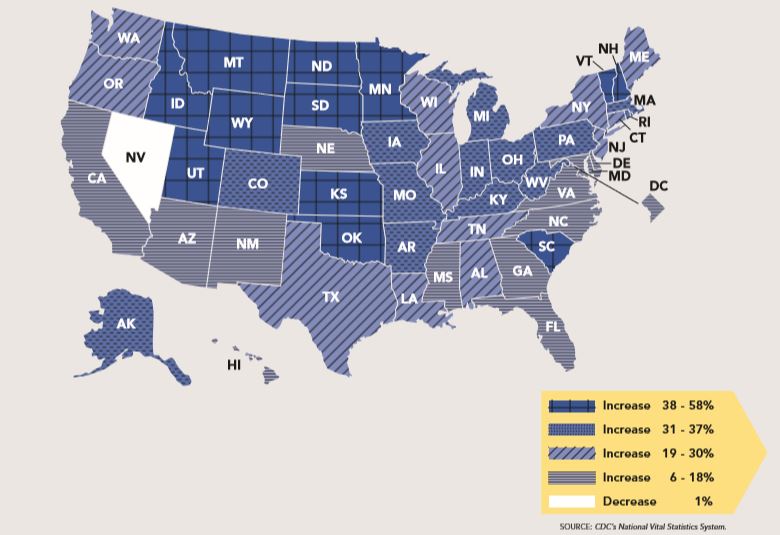Suicide Rates Increase in Nearly All States

In a concerning trend, deaths from suicide have increased in nearly every U.S. state in recent years, according to a new report from the Centers for Disease Control and Prevention.
The report found that from 1999 to 2016, suicide rates increased in 49 states, with 25 states experiencing increases of more than 30 percent. Overall, nearly 45,000 people died by suicide in 2016, which is more than twice the number of deaths from homicide, the CDC said.
Suicide is "a tragedy for families and communities across the country," Dr. Anne Schuchat, the principal deputy director of the CDC, said in a statement. "From individuals and communities, to employers and health care professionals, everyone can play a role in efforts to help save lives and reverse this troubling rise in suicide." [5 Myths About Suicide, Debunked]
Although suicide is often attributed solely to mental health conditions, it is rarely caused by a single factor, the researchers said. Indeed, the report found that more than half of people who died by suicide did not have a diagnosed mental health condition at the time of their death. Other problems often contribute to suicide risk, such as relationship problems, substance use, or financial or job stress.
Still, Schuchat stressed that better recognition of mental health conditions and improved access to mental health care remain important in preventing suicides.
But "if we only look at this as a mental health issue, we won't make the progress that we need," Schuchat said in news conference today (June 7). People can help prevent suicide by recognizing the warning signs, as well as the circumstances that often lead up to suicide, and take this as an opportunity to reach out to the person and help them get the help they need, Schuchat said.
According to #BeThe1To, a public health campaign by the National Suicide Prevention Lifeline, warning signs for suicide can include talking about feeling hopeless, trapped or like a burden to others; talking about wanting to die; increasing drug and alcohol use; acting anxiously or behaving recklessly; withdrawing from people; and experiencing extreme mood swings.
Sign up for the Live Science daily newsletter now
Get the world’s most fascinating discoveries delivered straight to your inbox.
If you or someone you know needs help, contact the National Suicide Prevention Lifeline at 1-800-273-TALK (8255).
Everyone can help
Suicide is the 10th leading cause of death in the United States, and just one of three leading causes of death that's on the rise, according to the CDC.
The new report also found that, among U.S. states and the District of Columbia, suicide rates varied fourfold in 2014-2016, from about 7 per 100,000 residents per year in Washington, D.C., to 29 per 100,000 residents per year in Montana.
During the study period, suicide rates increased in nearly all states, with increases ranging from about 6 percent in Delaware to 57 percent in North Dakota. In Nevada, the only state that saw a decrease, the rate fell by 1 percent. (But Nevada still had a relatively high suicide rate during the study period.)
Preventing suicide requires help from all sectors of society, the researchers said. For example, states can help by expanding options for temporary assistance for those struggling with financial or housing stress; health care systems can help by offering treatment options by phone or online in places where services are not widely available; and communities can help by offering programs and events that bring people together so they feel connected. Everyone can help by learning the warning signs for suicide and how to respond.
Original article on Live Science.

Rachael is a Live Science contributor, and was a former channel editor and senior writer for Live Science between 2010 and 2022. She has a master's degree in journalism from New York University's Science, Health and Environmental Reporting Program. She also holds a B.S. in molecular biology and an M.S. in biology from the University of California, San Diego. Her work has appeared in Scienceline, The Washington Post and Scientific American.









